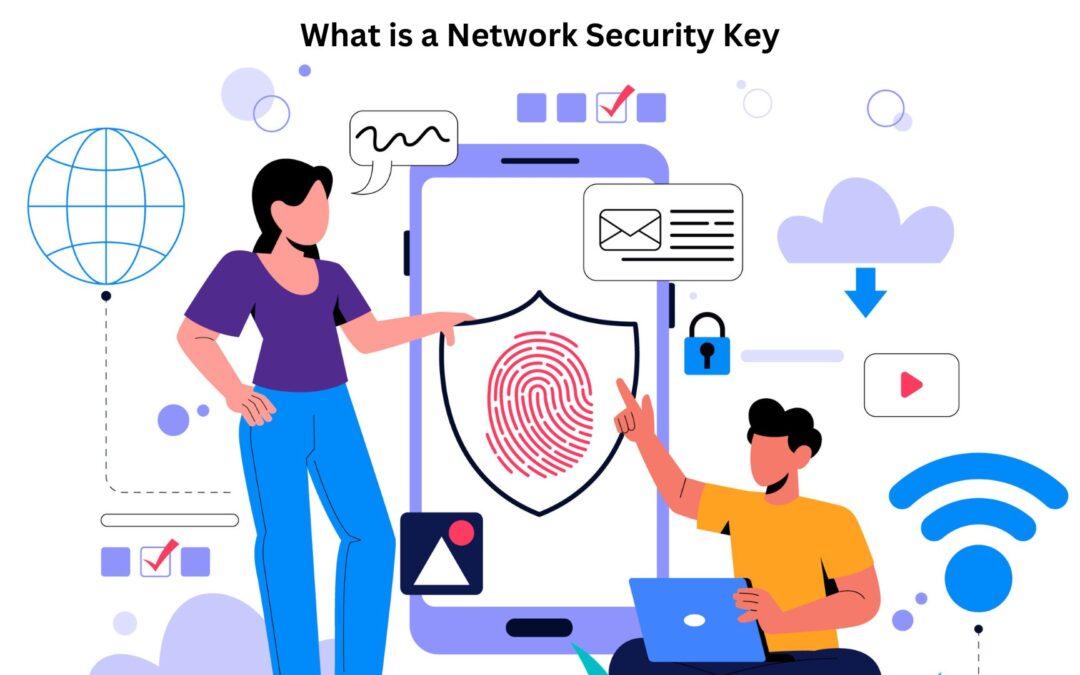In today’s digital age, where practically everything from our personal information to our financial data is stored online, securing our wireless networks has never been more important. Whether you’re working remotely, streaming movies, or just browsing the web, your internet connection is a direct link between your devices and the rest of the world. Without proper security, your personal data could be exposed to hackers or unauthorized users.
One essential element of network security is something called a network security key. But what is a network security key, and why is it so vital for protecting your internet connection? This blog will not only define a network security key but also walk you through how to find it, common issues related to it, and tips for securing your network with a strong key.
What is a Network Security Key?
If you’re asking yourself, “What is a network security key?”—you’re not alone. As the world becomes more digitally connected, understanding the basics of network security is essential for both personal and professional use. A network security key is essentially the password that safeguards your Wi-Fi network from unauthorized access, protecting you from cyberattacks and ensuring that only trusted devices can connect.
Here’s a step-by-step breakdown of what is a network security key is and what it does:
Authentication Tool: A network security key acts as a digital lock, requiring any device trying to connect to the Wi-Fi network to provide the correct key before access is granted. This ensures that only authorized users can join the network.
Encryption & Security: The network security key also plays a crucial role in encrypting the data transferred between devices and your router. Encryption means that even if someone intercepts your internet traffic, they won’t be able to read the information without the correct key.
Wireless Network Protection: Specifically used for wireless networks (Wi-Fi), network security keys are critical for preventing unauthorized access. They stop potential intruders from stealing your bandwidth or, worse, infiltrating your network and accessing your personal or professional data.
Encryption Protocols: Different encryption protocols, such as WPA (Wi-Fi Protected Access), WPA2, and WPA3, are used in conjunction with network security keys. These protocols determine the strength of the encryption and how well your network is protected.
To put it simply, a network security key is like the password for your wireless internet connection. Just as you wouldn’t leave the door to your house unlocked, you shouldn’t leave your Wi-Fi network open for anyone to use. The key keeps your network secure and ensures that only people who know the password can access it.

Types of Network Security Keys
Not all network security keys are created equal. Over the years, several types of encryption methods have been developed to improve network security. Understanding the differences between these types will help you choose the best protection for your Wi-Fi network.
Here are the most common types of network security keys:
1. WEP (Wired Equivalent Privacy)
Overview: WEP was one of the earliest network security standards designed to provide the same level of security in wireless networks as a wired network would offer. It relies on a static encryption key that remains the same across all devices on the network.
Strengths: It was revolutionary at the time, providing basic encryption to Wi-Fi networks.
Weaknesses: WEP has significant vulnerabilities and can be easily hacked using widely available tools. It is now considered obsolete and is no longer recommended for use.
Despite being one of the earliest forms of wireless encryption, WEP is widely known to be insecure. Hackers can break WEP encryption in minutes using easily available software. As a result, WEP is rarely used today, and it’s advisable to avoid it if possible.
2. WPA (Wi-Fi Protected Access)
Overview: WPA was introduced as an improvement over WEP, providing more robust encryption methods and better protection for wireless networks. WPA uses a dynamic encryption key, which changes periodically to enhance security.
Strengths: WPA offers improved security compared to WEP. By frequently changing the encryption key, it becomes more difficult for hackers to intercept data.
Weaknesses: WPA, while stronger than WEP, is still vulnerable to certain attacks, especially if weak passwords are used.
WPA was a significant improvement over WEP because it introduced TKIP (Temporal Key Integrity Protocol), which dynamically changes the encryption key used to secure wireless networks. This dynamic approach made it much harder for attackers to crack the key.
3. WPA2 (Wi-Fi Protected Access II)
Overview: WPA2 is the most widely used network security protocol today. It uses the Advanced Encryption Standard (AES), which is considered highly secure. It also introduced improvements over WPA, such as the ability to generate a new encryption key for every session.
Strengths: WPA2 provides strong encryption and is difficult to crack, making it one of the most secure options for protecting your wireless network. It remains the standard for most modern routers and devices.
Weaknesses: While WPA2 is highly secure, it’s not completely invulnerable. Attackers could still potentially breach a WPA2 network using techniques such as brute-force attacks, especially if weak passwords are used.
WPA2 is the default option for most modern routers, offering powerful encryption to protect your Wi-Fi network. Its AES encryption is used by governments, corporations, and individuals alike to safeguard sensitive data.
4. WPA3 (Wi-Fi Protected Access III)
Overview: WPA3 is the latest generation of wireless security standards, offering even stronger encryption and protections than WPA2. WPA3 makes brute-force attacks (where attackers try different combinations to guess your password) significantly harder.
Strengths: WPA3 provides enhanced security by using a more advanced form of encryption. It also includes features like forward secrecy, which prevents attackers from accessing previously transmitted data even if they manage to crack your password in the future.
Weaknesses: WPA3 is relatively new and not yet supported by all devices. However, it’s rapidly becoming the gold standard in wireless security.
For most users, WPA2 offers sufficient protection, but if you have a newer router that supports WPA3, it’s worth upgrading to take advantage of the additional security features.
How to Find Your Network Security Key
Knowing what is a network security key and where to find it can come in handy, whether you’re setting up a new device, resetting your network, or troubleshooting a connection issue. The good news is that finding your network security key is usually a straightforward process.

Method 1: Find It on Your Router
One of the easiest ways to find your network security key is to check the physical label on your router. Most routers come with a default key printed on a sticker.
Router Label: Look for the sticker on the side or bottom of the router. You should see something labeled as WPA Key, WPA2 Passphrase, or Wireless Key.
Use the Default Key: The default network security key is often printed on the label, especially if you haven’t changed it. Keep in mind, though, that using the default key can make your network more vulnerable, so it’s a good idea to change it to something more secure.
While the default network security key is convenient for first-time setup, it’s best to change it to something more complex to enhance your network’s security.
Method 2: Find It on Windows
If you’re using a Windows computer and are already connected to the Wi-Fi network, you can find your network security key through the system settings.
Open Network Settings: Go to Control Panel and click on Network and Internet, then Network and Sharing Center.
Select Your Network: Click on your Wi-Fi network’s name. A new window will appear.
View Security Key: In the window, click Wireless Properties, then go to the Security tab. Check the box next to Show characters to reveal your network security key.
This method is particularly useful if you’ve forgotten your network security key but are still connected to the network.
Method 3: Find It on macOS
For Mac users, finding the network security key involves using the Keychain Access utility, where macOS stores saved passwords.
Open Keychain Access: Navigate to Finder, click on Applications, then Utilities, and open Keychain Access.
Search for Your Wi-Fi Network: In Keychain Access, search for your Wi-Fi network name in the list of saved networks.
Reveal the Password: Double-click on your network, then check the box labeled Show password. Enter your administrator password to confirm, and your network security key will be displayed.
Using Keychain Access is a quick way to retrieve the network key on a Mac without needing to access your router.
Method 4: Find It Through Your Router’s Settings
You can also access your router’s settings to find or change the network security key.
Open a Web Browser: On a device connected to the network, open a web browser and type your router’s IP address into the address bar (commonly 192.168.1.1 or 192.168.0.1).
Log In to the Router: Use the router’s admin credentials to log in. These are often printed on the router label.
Find the Security Key: Navigate to the wireless settings section, where you’ll see the current network security key or password.
Finding the key through the router’s settings gives you full control over your network, allowing you to view or change the password as needed.
Common Network Security Key Issues
Even with the best intentions, you may run into problems when using or configuring a network security key. Below are some common issues people encounter, along with tips for solving them.
1. Network Key Mismatch
A network key mismatch occurs when the key entered during the connection attempt doesn’t match the actual network security key. This can happen if you enter the password incorrectly, or if the network settings were changed without updating the devices trying to connect.
Solution: Double-check the network security key, ensuring it is entered exactly as shown. Pay special attention to capitalization, spaces, and special characters. It’s also worth checking if you or someone else recently changed the network key, which might be causing the mismatch.
This issue is easily resolved but can be frustrating, especially if there are several characters to input. Taking a moment to verify the key before re-entering it can save you a lot of trouble.
2. Network Connection Issues
Sometimes, you might experience connectivity problems even if you’ve entered the correct network security key. These can be caused by interference, outdated hardware, or other configuration issues.
Solution: Start by restarting your router and the device trying to connect. If the problem persists, try forgetting the network on your device and reconnecting using the correct key. Make sure that your router’s firmware is up to date, and consider changing the wireless channel if interference from nearby networks is suspected.
Network connection issues can often be fixed with basic troubleshooting, but in some cases, it may be necessary to reset your router’s settings and configure the network from scratch.
3. Outdated Security Protocols
If your router is using an outdated security protocol like WEP or WPA, you might run into problems with modern devices. Many new devices require WPA2 or WPA3 for secure connections, and older protocols may cause compatibility issues or weak encryption.
Solution: Check your router’s security settings and upgrade to WPA2 or WPA3 if possible. If your router doesn’t support these protocols, it may be time to invest in a new one.
Upgrading your network’s security settings not only solves connection problems but also enhances the protection of your data.
How to Change Your Network Security Key
There are several reasons why you might want to change your network security key. Perhaps you’ve shared it with too many people, or maybe you’re concerned about security and want to create a stronger key. Whatever the reason, changing your network security key is a straightforward process.
Steps to Change Your Network Security Key:
Log In to Your Router:
Open a web browser and enter your router’s IP address (this is usually printed on the router or provided by your internet service provider).
Enter your router’s username and password. If you haven’t changed these, they may still be set to the default credentials (check the label on your router).

Navigate to the Wireless Security Settings:
Once you’ve logged in, look for the Wireless or Wi-Fi settings tab in the router’s admin panel. Here, you’ll find an option for security settings or passwords.
Set a New Network Security Key:
In the security settings, you’ll see the current network security key (this is the same as your Wi-Fi password). Delete the old key and replace it with a new, more secure password.
Make sure your new password follows best practices—using a mix of letters, numbers, and special characters, and avoiding easily guessable information.
Update the Security Protocol (Optional):
While you’re in the router settings, check whether you can upgrade your network’s security protocol. If it’s set to WEP or WPA, switch to WPA2 or WPA3 for better protection.
Save the Changes:
After updating the network security key and security protocol, be sure to save the settings. The router will update, and your devices will be disconnected temporarily.
Reconnect Devices:
Now that the key has changed, you’ll need to reconnect all of your devices using the new password. This includes smartphones, computers, tablets, smart TVs, and any other devices connected to your Wi-Fi network.
Changing your network security key is a great way to ensure your network stays secure, especially if you suspect that unauthorized users may have gained access.
How Can You Create a Strong Network Security Key?
What is a network security key? A strong network security key is critical to maintaining a secure wireless network. But how do you create a password that’s difficult for hackers to crack, yet easy enough for you to remember?

Characteristics of a Strong Network Security Key:
Length Matters: Longer passwords are more secure than shorter ones. Aim for at least 12 characters, though 16 or more is even better.
Use a Mix of Characters: Include uppercase letters, lowercase letters, numbers, and special symbols (!, @, #, etc.). The more varied your key, the harder it is to crack.
Avoid Predictable Patterns: Don’t use easily guessable words or phrases, such as “password,” “123456,” or your name. Try to avoid words from the dictionary altogether, as these are commonly targeted by hackers in brute-force attacks.
Randomness is Key: The more random your password the harder it is to guess. If you’re having trouble coming up with something random, consider using a password generator tool, which can create strong, unique passwords for you.
Avoid Reusing Passwords: It can be tempting to use the same password across multiple accounts or devices, but this makes it easier for hackers to access everything if they manage to crack one password. Always use a unique key for your Wi-Fi network.
By following these tips, you can create a network security key that’s far more difficult for attackers to break.
Benefits of Having a Secure Network Security Key
Having a strong network security key is about more than just keeping people off your Wi-Fi. It offers several broader benefits that protect your personal information, your devices, and your overall internet experience.
1. Protect Your Data from Hackers
A secure network key prevents unauthorized users from accessing your Wi-Fi and, by extension, your personal data. Hackers can exploit unsecured networks to intercept communications, steal personal information, or even gain access to your devices.
Example: Imagine you’re doing online banking, and someone nearby gains access to your network. They could potentially intercept your login details and financial information. A strong network security key helps prevent this.

2. Prevent Bandwidth Theft
When someone uses your Wi-Fi without permission, they’re consuming your bandwidth—slowing down your connection, and potentially increasing your data usage (if your ISP imposes data caps). A strong network security key ensures that only you and authorized users can access the full speed of your internet.
Example: If your Wi-Fi network is unsecured, your neighbors could be streaming movies or downloading large files on your connection, causing buffering and slower speeds for your own devices.
3. Prevent Malware and Virus Infiltration
Hackers who gain access to your Wi-Fi can potentially spread malware or viruses to your connected devices. Once inside your network, they could plant malicious software that compromises your data or allows them to monitor your activity.
Example: A hacker could install spyware on your devices, tracking your keystrokes to steal passwords, credit card numbers, and other sensitive information.
4. Safeguard IoT Devices
Today’s homes are filled with smart devices—everything from smart TVs to thermostats and security cameras. These devices often have weaker security than computers or smartphones, making them prime targets for hackers if your network isn’t secured by a strong key.
Example: A hacker could take control of your smart thermostat or camera if they gain access to your network, potentially spying on your home or manipulating your devices.
Tips for Choosing a Strong Network Security Key
When choosing a network security key, it’s essential to strike the right balance between security and usability. Here are some additional tips to help you pick a strong, effective key:
1. Avoid Personal Information
Don’t use names, birthdates, addresses, or other personal information in your network security key. These are often the first things hackers will try if they’re targeting your network.
2. Use a Password Manager
If you struggle to remember complex passwords, consider using a password manager. These tools can generate strong, random passwords for you and store them securely, so you don’t have to worry about forgetting them.
3. Change Your Key Regularly
Make it a habit to change your network security key every few months to ensure that your network remains secure. While it may seem like a hassle to update all your devices, regular password changes can help protect against long-term vulnerabilities.
4. Keep It Confidential
Don’t share your network security key with anyone who doesn’t need it. If you frequently have guests, consider setting up a guest network that allows temporary users to access your Wi-Fi without exposing your main network key.
5. Avoid Writing It Down
Writing down your network security key might seem like an easy way to remember it, but it also makes your network vulnerable if the paper falls into the wrong hands. Instead, store your key securely in a password manager or memorize it.
By following these tips, you can create a network security key that offers robust protection while remaining convenient to use.
Conclusion
In an age where our lives are increasingly intertwined with the internet securing your wireless network is not just a good idea—it’s essential. So, what is a network security key? It’s the first line of defense between your personal information and the rest of the world. A secure network security key keeps hackers at bay, protects your data, and ensures that only authorized users can connect to your Wi-Fi.
What is a network security key? From understanding the different types of network security keys to learning how to create a strong one, this guide has covered all the key aspects (pun intended) of network security. By following these tips, you can ensure that your network remains secure and your online experience is worry-free.
Remember, cybersecurity starts with you. Take the time to create and maintain a strong network security key, and you’ll be safeguarding your digital life against the ever-present threats that exist in today’s connected world.




